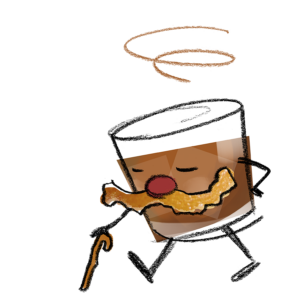 OLD FASHIONED
OLD FASHIONED
Traditional (1750s)
expressed orange and/or lemon oil
3 dashes Angostura bitters
1 tsp rich demerara syrup
2 oz overproof rye or bourbon whiskey
Garnishes: orange twist, lemon twist, or both — cherry if you feel like it
The Old Fashioned is essentially the original cocktail. While the practice of mixing various ingredients with beverage alcohol goes back thousands of years, the specific inclusion of bitters is what makes this drink a “cocktail,” as far the historical usage of the term goes. To make bitters, dried roots, barks, spices, citrus peel, edible flowers, and other botanicals are given a bath in high-proof spirit to extract their essential compounds, an old folk-medicine practice. The first known bitters were patented in London in 1712 as a cure-all tonic to help settle the stomach or to mix with wine or brandy as a hangover cure. Around 1750, people started adding a bit of sugar and water to their concoctions to make the flavor more palatable. Calling this a mix a “cocktail” first saw print mention in 1806, when it had transitioned from the medicine cabinet to become a recreational delight. As the century marched on, an array of new drinks emerged with unique names, so people then came to specify this one as the “Old-Fashioned Cocktail.” The Pendennis Club in Louisville, Kentucky, standardized the name and recipe as a bourbon drink — but perhaps more than any other drink recipe, this one is adaptable to just about any spirit you care to try. During Prohibition’s restricted access to “the good stuff” and as palates changed, people started to add muddled oranges, cherries, and other “garbage” to make the drink work for them. A drowning in seltzer was the final disgrace. And that way became the standard until the next turn of the century, when bartenders returned to the original 19th-century formula of spirit, sugar, water (as ice), and bitters — with a little spray of citrus oil that perfectly unifies the caramel and vanilla of the whiskey with the earthy baking spices of the bitters. What’s old is new again.


 ROCKS
ROCKS